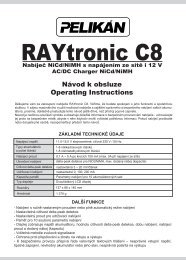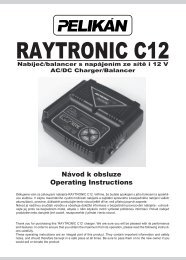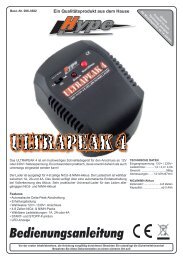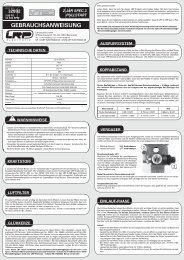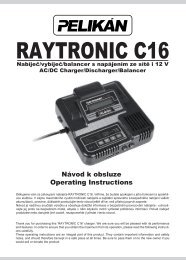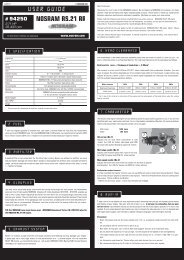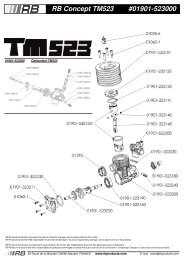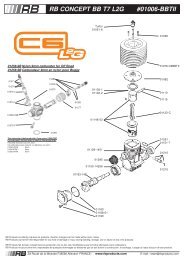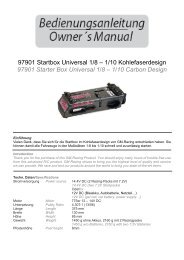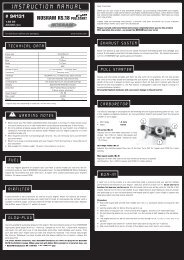LiPo Balancer 6 Plus - Graupner
LiPo Balancer 6 Plus - Graupner
LiPo Balancer 6 Plus - Graupner
- No tags were found...
You also want an ePaper? Increase the reach of your titles
YUMPU automatically turns print PDFs into web optimized ePapers that Google loves.
BEDIENUNGSANLEITUNGOPERATING MANUALINSTRUCTIONS D´UTILISATIONBest.-Nr. 3065Order-No.3065Rèf. No. 3065<strong>LiPo</strong> <strong>Balancer</strong> 6 <strong>Plus</strong>Die Ultra-Präzise Microcontroller gesteuerte Elektronik sorgtfür minimalste Spannungsdifferenzen und bietet das Maximum an Sicherheit!The ultra precious microcontroller supervised electronic providesminimal voltage differences and offer maximal safety.Le micro-contrôleur ultra-précis qui pilote l’électronique assure des différences de tensionminimales et offre un maximum de sécuritéSeite 2 page 8 page 14G R A U P N E R GmbH & Co. KG D - 7 3 2 3 0 K I R C H H E I M / T E C K G E R M A N YKeine Haftung für Druckfehler! Änderungen vorbehalten!PN.LA-1
Allgemeine SicherheitshinweiseAllgemeinesUm alle Eigenschaften Ihres neuen <strong>Balancer</strong>svoll nutzen zu können, lesen Sie vor Inbetriebnahme,die nachfolgende Beschreibung vollständigund sorgfältig durch. Beachten Sie vor allemdie Warn- und Sicherheitshinweise. Diese Anleitungist an einem sicheren Ort aufzubewahrenund einem nachfolgenden Benutzer des Gerätsunbedingt mit auszuhändigen.Mit dem <strong>LiPo</strong> <strong>Balancer</strong> 6 <strong>Plus</strong> haben Sie einausgereiftes Produkt mit überragenden Eigenschaftenerworben. Durch den Einsatz modernsterHalbleitertechnologie, gesteuert durcheinen leistungsfähigen RISC-Microprozessorwerden überragende Sicherheitseigenschaften,einfache Bedienbarkeit und optimale Zuverlässigkeit,erreicht.Mit dem <strong>LiPo</strong> <strong>Balancer</strong> 6 plus lassen sich 2-6Lithium Zellen ausgleichen. Bei einer Reihenschaltungzweier <strong>Balancer</strong> (siehe S. 7) ist esmöglich bis zu 12 Zellen auszugleichen.HinweisEs sind stets die Ladehinweise der Akkuherstellerzu beachten, sowie die Ladeströme undLadezeiten einzuhalten. Es dürfen nur Akkusschnellgeladen werden, welche ausdrücklich fürdiesen hohen Ladestrom geeignet sind!Lithium-Polymer Zellen sind sehr empfindlich.Daher dürfen diese nur unter Aufsicht währenddes gesamten Ladevorgangs geladen werden.Warn- und Sicherheitshinweise• Das Gerät vor Staub, Feuchtigkeit, Regen,Hitze (z. B. direkte Sonneneinstrahlung) undVibration schützen. Nur zur Verwendung imTrockenen!• Die Schlitze im Gehäuse dienen der Kühlungdes Geräts und dürfen nicht abgedeckt oderverschlossen werden. Das Gerät musswährend des Ladevorgangs frei aufgestelltsein, damit die Luft ungehindert zirkulierenkann.• Das Gerät ist für den Anschluss an ein fürLithium-Polymer Zellen geeignetes Ladegerätanzuschließen. Verwenden Sie nur Originalkabel. Aus Sicherheitsgründen sind Umbau-2 Sicherheitshinweisemaßnahmen am Ein- und Ausgang zu unterlassen.• Das Ladegerät, der <strong>LiPo</strong> <strong>Balancer</strong> <strong>Plus</strong> unddie zu ladende Batterie muss währenddes Betriebs auf einer nicht brennbaren,hitzebeständigen und elektrisch nicht leitendenUnterlage stehen! Niemals direkt aufden Autositzen, Teppiche o. ä. abstellen!Auch sind brennbare oder leicht entzündlicheGegenstände von der Ladeanordnung fernzuhalten.Auf gute Belüftung achten!• Verbinden Sie das Gerät nur direkt mit denOriginal-Anschlussleitungen mit dem Ladegerätund Akku.• Die Ladeausgänge und die Anschlusskabeldürfen nicht verändert oder untereinanderin irgendeiner Weise verbunden werden.Anschlusskabel dürfen während des Betriebsnicht aufgewickelt sein! Vermeiden Sie Kurzschlüssemit dem Ladeeingang / Ladeausgangbzw. dem Akku und der Autokarosserie.Stellen Sie deshalb das Gerät niemals direktauf die Fahrzeugkarosserie.• Lassen Sie den Ladevorgang niemals unbeaufsichtigt.• Es darf nur ein zu ladender Akku an denLadeanschluss angeschlossen werden.• Es dürfen nur Lithium-Polymer Zellen mit biszu 6 Zellen angeschlossen werden.• Um Kurzschlüsse am <strong>Balancer</strong> zu vermeiden,verbinden Sie immer zuerst das GRAUPNERMesskabel für die Einzelzellen mit Ihrem<strong>Balancer</strong>, anschließend eines der normalenLadekabel Ihres <strong>Balancer</strong>s, bevor die Eingangskabelmit dem zu verwendeten Ladegerätverbunden werden. Achten Sie darauf,dass die beiden Eingangskabel nicht kurzgeschlossenwerden, während der <strong>LiPo</strong><strong>Balancer</strong> <strong>Plus</strong> aktiviert ist, da sonst das Gerätbeschädigt werden kann bzw. die Sicherungunterbricht.HaftungsausschlussDie Einhaltung der Betriebsanleitung sowie dieBedingungen und Methoden bei Installation,Betrieb, Verwendung und Wartung des Ladegeräteskönnen von der Fa. GRAUPNER nichtüberwacht werden. Daher übernimmt die
Allgemeine BetriebshinweiseFa. GRAUPNER keinerlei Haftung für Verluste,Schäden oder Kosten, die sich aus fehlerhafterVerwendung und Betrieb ergeben oder in irgendeinerWeise damit zusammenhängen.1. Auflage, Printed in Korea PN.LA-01Dieses Handbuch dient ausschließlich Informationszwecken,kann ohne Vorankündigunggeändert werden und ist nicht als Verpflichtungder Firma GRAUPNER anzusehen. Die FirmaGRAUPNER übernimmt keine Verantwortungoder Haftung für Fehler bzw. Ungenauigkeiten,die im Informationsteil dieses Handbuches auftretenkönnen.Vor dem Laden prüfenSind alle Verbindungen einwandfrei, gibt es Wackelkontakte?Bitte bedenken Sie, dass das Schnellladen vonBatterien gefährlich sein kann. Eine, wenn auchnur kurze Unterbrechung aufgrund eines Wackelkontaktsführt unweigerlich zu Fehlfunktionen,kann zu einem erneuten Ladestart führen.Laden von Akkus• Akkus dürfen nur unter Aufsicht geladenwerden!• Akkus NUR auf einem feuerfesten Untergrundladen!(<strong>Graupner</strong> <strong>LiPo</strong> Sicherheitskoffer Best.-Nr.8370 (klein) oder Best.-Nr. 8371 (groß)• Defekte oder aufgeblähte Lithium Zellendürfen auf keinen Fall erneut geladen werden!• Der zu ladende Akku wird über die beidenoriginalen Stecker für GRAUPNER Lithium-Polymer Zellen angeschlossen• Achten Sie auf sicheren und guten Kontaktaller Steck- und Klemmverbindungen. Eineauch nur kurzzeitige Unterbrechung aufgrundeines Wackelkontakts kann einen erneutenLadestart auslösen und den angeschlossenenAkku u. U. total überladen.Lithium-Polymer ZellenDer <strong>LiPo</strong>-<strong>Balancer</strong> plus ist nur zum ausbalancierenvon Lithium-Polymer-Akkus mit einer ZellenNennspannung von 3,7 V/Zelle oder von Li-IonenAkkus mit einer Nennspannung von3,6V/Zelle geeignet.Lithium-Akkus zeichnen sich vor allem durchihre, im Vergleich zu anderen Akkutypen,wesentlich höheren Energiedichte aus.Dieser wesentliche Vorteil auf der einen Seiteerfordert jedoch andere Behandlungsmethodenin Bezug auf die Ladung / Entladung sowie füreinen gefahrlosen Betrieb.Die hier grundlegenden Vorschriften müssenauf alle Fälle beachtet werden. Weitere entsprechendeAngaben und Sicherheitshinweise entnehmensie bitte den technischen Angaben desAkkuherstellers.Prinzipiell können Akkus auf Lithiumbasis NURmit speziellen Ladegeräten geladen werden, dieauf den jeweiligen Akkutyp (Ladeschlussspannung,Kapazität) eingestellt sind.Die Aufladung erfolgt anders als bei NiCd- oderNiMH-Akkus durch eine sog. Konstantstrom/Konstantspannungs-Methode. Der <strong>LiPo</strong> <strong>Balancer</strong>wird zwischen das Ladegerät und den zuladenden Akku geschaltet und balanciert sobaldangeschlossen, den Akku aus.<strong>LiPo</strong>-<strong>Balancer</strong> plus mit Lade-/Entladeschutzfür 2-6 ZellenDer <strong>LiPo</strong>-<strong>Balancer</strong> 6 plus mit Überladeschutzund Tiefentladeschutz ist die optimale Schaltungfür jeden Modellbauer. Für eine maximaleSicherheit und maximale Lebensdauer ist dieseSchaltung zwingend erforderlich, denn sie verhindertdas Überladen einzelner Zellen zuverlässig.Zusammen mit dem Tiefentladeschutz imModell Best.-Nr. 6495 erreichen Sie einen deutlichsichereren Betrieb und höhere ZyklenzahlenIhrer wertvollen Akkupacks!Der <strong>LiPo</strong>-<strong>Balancer</strong> 6 plus bringt alle in Reihe geschaltetenZellen eines <strong>LiPo</strong>-Akkus auf das gleicheSpannungsniveau. Dies ist erforderlich, weildurch Alterung oder Entladung unterschiedlicheLadezustände bzw. Spannungslagen erreichtwerden. Das Angleichen der Zellen startet sofortnach dem Anstecken des Akkupacks und wirdüber den gesamten Ladevorgang fortgesetzt.Allgemeine Betriebshinweise 3
InbetriebnahmeÜberladeschutz durch ÜberspannungsabschaltungWenn eine Zelle die Spannung von 4,26V erreicht,wird der Ladevorgang sofort unterbrochen,um diese Zelle sicher vor einer schädlichenÜberladung zu schützen. Dies kann der Fall sein,wenn am Ladegerät die falsche Zellenzahl oderder falsche Akkutyp gewählt wurde bzw. wenneine Zelle einen Defekt aufweist.Die Sicherheit wird dadurch um ein Vielfacheserhöht. Der <strong>LiPo</strong>-<strong>Balancer</strong> 6 plus wird sowohlüber den weißen, mehrpoligen Stecker, wie auchüber den Hochstromstecker des Akkus angeschlossen.Dadurch wird eine Verfälschung desMessergebnisses durch den Ladestrom vermieden,so dass die einzelnen Zellen perfekt ausgeglichenwerden.Überprüfung der Lithiumakkus!Achtung! Bevor Sie Ihren <strong>LiPo</strong> <strong>Balancer</strong> 6 plusin Betrieb nehmen, überprüfen Sie unbedingt diekorrekte Pin-Belegung des mehrpoligen weißenSteckers Ihres <strong>LiPo</strong> Akkus wie folgt.Am besten dazu eignet sich ein Voltmeter, wiez.B. Best.-Nr. 1955 Zangen-Ampere/Multimeter.Bei falscher Pin-Belegung wird das Ladegerätund der Akku zerstört. Explosionsgefahr!Pin 1: Masse (schwarzes Kabel)Pin 2: 3,7V (Zelle 1)Pin 3: 7,4V (Zelle 2)Pin 4: 11,1V (Zelle 3)Pin 5: 14,8V (Zelle 4)Pin 6: 18,5V (Zelle 5)Pin 7: 22,2V (Zelle 6)Beispiel: 3-zelliger Akkupack4 InbetriebnahmeInbetriebnahmeSchließen Sie Ihren <strong>LiPo</strong> <strong>Balancer</strong> 6 plus zwischenIhrem Ladegerät und dem zu ladenden<strong>LiPo</strong> Akku an.Generell sollten Sie zuerst den Akku mit demmehrpoligen, weißen Stecker an den <strong>Balancer</strong>anschließen, bevor Sie innerhalb von 12 Sekundenden Hochstromstecker mit dem <strong>Balancer</strong>verbinden.Bereits ab diesem Zeitpunkt beginnt das Gerätdie <strong>LiPo</strong> Zellen auszubalancieren, ohne das einLadegerät angeschlossen wird.Zum Laden bzw- Entladen des Akkus verbindenSie das zum Ladegerät passende Eingangkabelmit Ihrem <strong>LiPo</strong> Ladegerät, siehe nachfolgendeAbbildung.LademodusSchließen Sie nun einen geeigneten originalGRAUPNER Lithium-Polymer Akkupack bis maximal6 Zellen wie beschrieben an.Entnehmen Sie die Ladeeinstellungen der BedienungsanleitungIhres Ladegerätes.Verbinden Sie den <strong>LiPo</strong> <strong>Balancer</strong> 6 plus wie zuvorbeschrieben.Der <strong>Balancer</strong> unterscheidet zwischen zwei Betriebsmodes,den „Connect Modus“ (verbunden)und den „Disconnect Modus“ (nicht verbunden)Disconnect Modus (nicht verbunden)Dieser Modus wird benötigt, wenn der <strong>Balancer</strong>nur mit einem Akku verbunden ist, diesen ausbalanciert,aber kein Ladegerät angeschlossen ist.Dadurch ist der Eingang auch Kurzschlussgeschützt.Um in den „Disconnect Modus“ zu gelangen,drücken Sie die MODE/RESET-Taste, wenn dieSTATUS LED langsam oder gar nicht blinkt.Der Disconnect Modus wird durch konstantesleuchten der STATUS LED signalisiert.
InbetriebnahmeConnect Modus (verbunden)Um einen Akku zu laden bzw. zu entladen, musssich der <strong>Balancer</strong> im „Connect Modus“ befinden,da ansonsten der Eingang deaktiviert ist.Dieser Modus wird durch ein konstantes,langsames blinken signalisiert.Um in den „Connect Modus“ zu gelangen, drückenSie die MODE-Taste, während die StatusLED dauerhaft leuchtet.Leuchtet und blinkt STATUS LED nicht, dannbefindet sich der <strong>Balancer</strong> im Engergiesparmodus.Drücken Sie die MODE-Taste so oftund so lange, bis die STATUS LED blinkt.Laden / Entladen eines AkkusUm einen Akku laden bzw. entladen zu können,muss sich der <strong>LiPo</strong> <strong>Balancer</strong> plus im„Connect Modus“ befinden. Zwischen dem„Connect- und Disconnect Modus“ wechseln Siemit der MODE Taste. Die STATUS LED blinkt nunlangsam im „Connect Modus“. Starten Sie nunden Ladevorgang an Ihrem Ladegerät.Der <strong>LiPo</strong> <strong>Balancer</strong> plus überwacht jede Zelle einzeln,gleicht diese während des Ladevorgangsaus und schützt vor Überladung Ihres Akkupacksdurch sofortigen Abbruch des Ladevorgangs beizu hoher Spannung der Zellen.Hinweis:- Der Anschlussstecker zum Ladegerät darf nurim „Disconnect Modus“ abgezogen werden.- Der Lithium Akku darf so lange der Akku geladenwird, nicht abgesteckt werden.Zum Abstecken muss sich der <strong>Balancer</strong> im„Disconnect Modus“ befinden.Zellenzähler LEDsFür jede angeschlossene <strong>LiPo</strong>Zelle, ist der <strong>LiPo</strong> <strong>Balancer</strong> 6<strong>Plus</strong> mit einer LED ausgestattet.Die entsprechende LED signalisiertdurch blinken, sobaldausbalanciert wird.Die Zellen 1, 3, 5 besitzen einerote LED, Zellen 2, 4, 6 verfügenüber eine grüne LED.Blinksequenzkurzes blinken: es fließt nur ein geringer AusgleichsstromDauerleuchten: es fließt der max. Ausgleichsstrom.Bevor ein Ladevorgang gestartet wird,sollte abgewartet werden, bis keine LED mehrdauerhaft leuchtet.Zellen sind ausba-lanciert der <strong>Balancer</strong>befindet sich imEnergiesparmodus.kein blinken,alle LEDs ausFehler ModusDie Status LED signalisiert neben dem „Connect“und „Disconnect“ Modus auch den Fehlermodus.Der Fehlermodus wird 10 Sekunden lang angezeigt,bevor das Gerät in den Energiesparmodusübergeht. Durch Drücken der Mode/Reset-Taste,können Sie den Fehlermodus bestätigen, sodassdieser gelöscht wird.Folgende Fehler-Modi werden unterschieden:Status LEDFunktion1x blinken/sekunde Prüfen der An-(x x x) schlusskonfigurationfür die Dauer von 12s2x blinken/sekunde Überspannung des(xx xx xx)Akkus3x blinken/sekunde Kurzschluss am Ein-(xxx xxx xxx)oder Ausgang4x blinken/sekunde Verbindungsfehler(xxxx xxxx xxxx)EnergiesparmodusDas Gerät schaltet sich automatisch in den Energiesparmodus,sobald der Akkupack ausbalanciertist um die Entladung des <strong>LiPo</strong> Akkus zuverhindern.Sobald Sie die MODE/RESET-Taste drücken,verlassen Sie den Energiesparmodus.Komponenten und ZubehörDie Firma GRAUPNER GmbH & Co. KG als Herstellerempfiehlt, Komponenten undInbetriebnahme 5
Technische Daten, KonformitätZubehörprodukte zu verwenden, die vonGRAUPNER auf Tauglichkeit, Funktion und Sicherheitgeprüft, freigegeben sind. GRAUPNERübernimmt für Sie die Produktverantwortung.Die Fa. GRAUPNER übernimmt für nicht freigegebeneTeile oder Zubehörprodukte von anderenHerstellern keine Haftung und kann nicht jedeseinzelne Fremdprodukt beurteilen, ob es ohneSicherheitsrisiko eingesetzt werden kann.Technische DatenEingangsspannung: max. 55 VAusgangsspannung: 6,0 ~ 30 VAkkutyp:<strong>LiPo</strong> 3,7V/ZelleLiIo 3,6V/ZelleZellenzahl:2 ~ 6 ZellenMax. Ladestrom: 10 ASpannungsauflösung: +/- 5 mVEingang:GoldkontaktsteckerAusgang:<strong>Graupner</strong> <strong>LiPo</strong>Stecker mehrpolig<strong>Graupner</strong> BEC undG4 SteckerTemperaturbereich: 0°C ... 35°CAbmessungen (L/B/H): ca. 120x71x24mm(ohne Anschlusskabel)Gewicht: ca. 105 g.Hinweise zum UmweltschutzDas Symbol auf dem Produkt, derGebrauchsanleitung oder der Verpackungweist darauf hin, dassdieses Produkt bzw. elektronischeTeile davon am Ende seiner Lebensdauernicht über den normalenHaushaltsabfall entsorgt werden dürfen. Esmuss an einem Sammelpunkt für das Recyclingvon elektrischen und elektronischen Geräten abgegebenwerden.Die Werkstoffe sind gemäß ihrer Kennzeichnungwiederverwertbar. Mit der Wiederverwendung,der stofflichen Verwertung oder anderen Formender Verwertung von Altgeräten leisten Sie einenwichtigen Beitrag zum Umweltschutz.Batterien und Akkus müssen aus dem Gerätentfernt werden und bei einer entsprechendenSammelstelle getrennt entsorgt werden.Bei RC-Modellen müssen Elektronikteile, wiez.B. Servos, Empfänger oder Fahrtenregleraus dem Produkt ausgebaut und getrennt beieiner entsprechenden Sammelstelle als Elektro-Schrott entsorgt werden.Bitte erkundigen Sie sich bei der Gemeindeverwaltungnach der zuständigen Entsorgungsstelle.EG-KonformitätserklärungFür das folgend bezeichnete Erzeugnis<strong>LiPo</strong> <strong>Balancer</strong> 6 plus Best.-Nr. 3065wird hiermit bestätigt, dass es den wesentlichenSchutzanforderungen entspricht, die in derRichtlinie des Rates zur Angleichung der Rechtsvorschriftender Mitgliedstaaten über die elektromagnetischeVerträglichkeit (89/336/EWG)festgelegt sind.Zur Beurteilung des Erzeugnisses hinsichtlichelektromagnetischer Verträglichkeit wurden folgendeNormen herangezogen:EN 50081-1EN 50082-1Diese Erklärung wird verantwortlich für denHersteller/Importeur<strong>Graupner</strong> GmbH & Co. KGHenriettenstr. 94-9673230 Kirchheim/Teckabgegeben durch73230 Kirchheim/Teck, den 11.01.07Hans <strong>Graupner</strong>Geschäftsführer6 Technische Daten, Konformität
<strong>LiPo</strong> <strong>Balancer</strong> 6 plus im Überblick<strong>LiPo</strong> <strong>Balancer</strong> 6 plus im ÜberblickSTATUS LED10A SicherungMODE/RESETMASTER/SLAVE-SchalterNetzwerkkabelanschlussEinzelzellen AUSGANGFür den Anschluss desmehrpoligen GRAUPNER<strong>LiPo</strong> <strong>Balancer</strong>kabelsEINGANG Ladegerät!! Es darf nur einer derbeiden Anschlüsse mitdem Ladegerät verbundenwerden!!AUSGANGFür denAnschlussdesHochstromsteckersIhres <strong>LiPo</strong>Akkus.!! Esdarf nureiner dieserbeidenAnschlüsseverwendetwerden !!Reihenschaltung von 2 <strong>Balancer</strong>n- Schalten Sie den Schalter des Master-<strong>Balancer</strong>s auf M. Schalten Sie den Schalter des Slave-<strong>Balancer</strong>sauf S.- Verbinden Sie den roten Anschluss (CHARGER) des Master-<strong>Balancer</strong>s mit Hilfe von zwei verlötetenund verschrumpften 4mm Goldbuchsen mit dem schwarzen Anschluss (CHARGER) desSlave-<strong>Balancer</strong>s.- Verbinden Sie den schwarzen Anschluss (CHARGER) des Master-<strong>Balancer</strong>s mit BATT. (-) des<strong>LiPo</strong>-Ladegerätes.- Verbinden Sie den roten Anschluss (CHARGER) des Slave-<strong>Balancer</strong>s mit BATT. (+) des <strong>LiPo</strong>-Ladegerätes.- Stecken Sie das Netzwerkkabel in die beiden <strong>Balancer</strong>- Schließen Sie die beiden <strong>LiPo</strong>-Akkupacks (<strong>Balancer</strong>anschluss und Hochstromanschluss) innerhalbvon 12 Sekunden an den Master-<strong>Balancer</strong> und Slave-<strong>Balancer</strong> an. Werden die beiden Akkuspacksnich innerhalb von 12 Sekunden angeschlossen, so arbeitet nur der Master-<strong>Balancer</strong>. Die beidenAkkupacks müssen dann komplett abgesteckt werden und innerhalb von 12 Sekunden erneutangesteckt werden. Während der 12 Sekunden blinkt die STATUS LED jede Sekunde, bis der/die<strong>Balancer</strong> die Anschlusskonfiguration erkannt hat.<strong>LiPo</strong> <strong>Balancer</strong> plus im Überblick 7
General Safety NotesIntroductionPlease be sure to read right through these operatinginstructions attentively before you attemptto use your new balancer, as this will ensure thatyou can make full use of all of its capabilities.Take particular note of the warnings and safetynotes. These instructions should be kept in asafe place; if you ever dispose of the charger, besure to pass them on to the new owner.The <strong>LiPo</strong> <strong>Balancer</strong> 6 <strong>Plus</strong> is a sophisticated productoffering a number of outstanding features.The use of the latest semi-conductor technology,controlled by a high-performance RISC microprocessor,provides outstanding safety characteristics,simplicity of operation and optimumreliability.The <strong>LiPo</strong> <strong>Balancer</strong> can be used to balance thestate of two to six Lithium cells. Up to twelve cellscan be balanced if two <strong>Balancer</strong>s are connectedtogether in series (see page 13).NoteAlways read and observe the charging instructionssupplied by the battery manufacturer, andkeep to the charge currents and charge timesstated in them. It is not safe to fast-charge Lithiumbatteries unless they are expressly stated tobe suitable for high charge currents.Lithium-Polymer cells are very sensitive.For this reason they should only ever be chargedin conditions where the entire charging processcan be supervised constantly.Warnings and safety notes• Protect the balancer from dust, damp, rain,heat (e.g. direct sunshine) and vibration. Itshould only be operated in dry indoor conditions.• The case slots serve to cool the charger, andmust not be covered or enclosed; set up thecharger with space all around it, so thatcooling air can circulate unhindered.• The device must be connected to a chargerdesigned for Lithium-Polymer cells, usingthe original cables only. For safety reasons itis important not to modify the inputs andoutputs of the device in any way.8 Safety Notes• The charger and the battery to be chargedshould be set up on a heat-resistant, noninflammableand non-conductive surfacebefore use. Never place the charger directlyon a car seat, carpet or similar surface. Keepall inflammable and volatile materials wellaway from the charging area, and providegood ventilation.• Connect the balancer directly to the chargerand the model battery only, using the originalcables and connectors supplied.• The charge output sockets and connectingleads must not be modified, and must not beinter-connected in any way. The charge leadsand connecting leads must not be coiled upwhen a charge process is in progress. Avoidshort-circuiting the charge input or output withthe model battery or the car bodywork. Forthis reason the unit must never be placeddirectly on the vehicle’s bodywork.• Never leave the charging system operatingwithout supervision.• Only one battery may be connected to thecharge output for charging at any one time.• The charger is only suitable for use withLithium-Polymer batteries consisting of up tosix cells.• To avoid short-circuiting the balancer, pleasekeep to this sequence of connections: alwaysconnect the GRAUPNER measuring lead forthe individual cells to your balancer first, thenone of your balancer’s standard charge leads,and only then connect the input cables tothe charger you intend to use. Take carenot to short-circuit the two input cables whilethe <strong>LiPo</strong> <strong>Balancer</strong> plus is active, as this coulddamage the unit or cause the fuse to blow.Liability ExclusionAs manufacturers, we at GRAUPNER are not ina position to ensure that you observe the correctmethods of operation when installing, using andmaintaining the balancer. For this reason we areobliged to deny all liability for loss, damage orcosts which are incurred due to the incompetentor incorrect use and operation of our products,or which are connected with such operation inany way.
General Operating Information1st edition, printed in Korea PN.LA-01The purpose of this manual is exclusively to provideinformation. It is subject to modification withoutprior notification, and must not be consideredto constitute an obligation on the part of theGRAUPNER company. GRAUPNER accepts noresponsibility or liability for errors or inaccuracieswhich may be found in the information sectionof this manual.Check before using the charging systemAre all connections firm, or is there an intermittentcontact at any point in the circuit?Please bear in mind that it can be dangerous tofast-charge batteries. For example, if there is abrief interruption due to an intermittent contact,the result is inevitably a malfunction, and thiscould cause the charge process to restart.Charging batteries• Batteries must be supervised constantly whenon charge.• Batteries must ALWAYS be placed on afire-proof surface for charging. (<strong>Graupner</strong><strong>LiPo</strong> Safety Case, Order No. 8370 (small) orOrder No. 8371 (large)).• Faulty or swollen Lithium cells must never berecharged again.• The battery to be charged must be connectedusing the two original connectors forGRAUPNER Lithium-Polymer cells.• Ensure that there are no intermittent contactsat any point in the charge circuit. If there is abrief interruption due to an intermittent contact,the result could be a restart of the chargeprocess, which would result in the pack beingmassively overcharged.Lithium-Polymer cellsThe <strong>LiPo</strong> <strong>Balancer</strong> plus is designed solely for balancingLithium-Polymer batteries with a nominalcell voltage of 3.7 V per cell, or Lithium-Ion batterieswith a nominal voltage of 3.6 V per cell.Compared to other battery types, the outstandingfeature of Lithium batteries is their much higherenergy density.However, this important advantage is balancedby increased risks, and it is necessary to adoptdifferent charging and discharging methods inorder to reduce the risk to a minimum.It is essential at all times to observe the basic instructionsprovided here. Please be sure to readthe information and safety notes provided by thebattery manufacturer, and keep within the statedtechnical limits.The basic rule is that Lithium-based batteries canONLY be charged using special chargers designedand adjusted to suit the specific battery type(final charge voltage and capacity).In contrast to NiCd and NiMH batteries, Lithiumbatteries have to be charged using what is knownas a constant current / constant voltage method.The <strong>LiPo</strong> <strong>Balancer</strong> is connected between thecharger and the battery to be charged, and startsto balance the voltages of the individual cells assoon as it is connected.<strong>LiPo</strong> <strong>Balancer</strong> plus with charge / dischargeprotection for 2 to 6 cellsThe <strong>LiPo</strong> <strong>Balancer</strong> 6 plus features protectionagainst overcharging and deep-discharging, andrepresents the ideal circuit for every modeller.The unit is absolutely essential for maximumsafety and effective useful life with these batteries,because it reliably eliminates the problemof overcharging individual cells. Used togetherwith the deep-discharge guard, Order No. 6495,which is fitted in the model, you can be sure ofmuch safer operation and higher cycle countsfrom your valuable battery packs.The <strong>LiPo</strong> <strong>Balancer</strong> 6 plus brings all the seriesconnectedcells in a <strong>LiPo</strong> battery to the samevoltage level. This is necessary, because ageingeffects and discharge processes can producedifferences in states of charge, i.e. cell voltage.The balancing of the cells starts immediatelywhen the pack is connected to the balancer, andthis process continues for the full duration of thecharge.General Operating Information 9
Using the balancer for the first timeOvercharging protection: over-voltage cutoffIf a cell reaches the voltage of 4.26 V, the chargeprocess is immediately broken off in order to protectthis cell from damage due to overcharging.This may occur if the wrong cell count or batterytype has been selected on the charger, or if onecell develops a fault. This single feature makesthe whole charging process many times safer.The <strong>LiPo</strong> <strong>Balancer</strong> 6 plus is connected to the batteryboth by the white multi-pin plug and also bythe standard high-current connector attached tothe pack. This arrangement avoids a falsificationof the measured results due to the influence ofthe charge current, with the net result that individualcells are perfectly balanced.Checking the Lithium battery! Caution ! Before you use your <strong>LiPo</strong> <strong>Balancer</strong> 6plus for the first time, it is essential to check thatthe pin assignment of the white multi-pin connectorattached to your Li-Po battery is correct. Thebest method is to use a voltmeter, e.g. Order No.1955: clamp ammeter / multimeter.If the pin assignment is incorrect, the chargerand the battery will be ruined. Explosionhazard!Pin 1: Earth (black wire)Pin 2: 3,7V (cell 1)Pin 3: 7,4V (cell 2)Pin 4: 11,1V (cell 3)Pin 5: 14,8V (cell 4)Pin 6: 18,5V (cell 5)Pin 7: 22,2V (cell 6)Example: 3-cell battery pack10 Using the balancer for the first timeUsing the balancer for the first timeConnect your <strong>LiPo</strong> <strong>Balancer</strong> 6 plus between thebattery charger and the <strong>LiPo</strong> pack you wish tocharge.As a general rule you should first connect thebattery to the balancer using the white multi-pinconnector, before connecting the high-currentconnectors to the balancer within 12 seconds.From this moment the device starts to balancethe voltage of the <strong>LiPo</strong> cells, even without beingconnected to a charger.To charge or discharge the battery, connect theinput cable matching your charger to your <strong>LiPo</strong>battery charger; see picture below.Charge modeConnect a suitable genuine GRAUPNER Lithium-Polymerbattery (max. six cells) as describedabove.Refer to the operating instructions supplied withyour battery charger for the correct charge settings.Connect the <strong>LiPo</strong> <strong>Balancer</strong> 6 plus as describedabove.The balancer differentiates between two operatingmodes: “Connect Mode” (connected) and“Disconnect Mode” (not connected).Disconnect Mode (not connected)This mode is required when the balancer is connectedto a battery in order to balance the cells’voltages, but no charger is connected. In thismode the input is short-circuit protected.To select “Disconnect Mode”, press the MODE /RESET button when the STATUS LED is flashingslowly or not flashing at all.The Status LED will now glow constantly to confirmDisconnect Mode.
Using the balancer for the first timeConnect mode (connected)To charge or discharge a battery the balancermust be in “Connect Mode”, otherwise the inputis disabled.The LED flashes constantly at a slow rate to confirmConnect Mode.To select “Connect Mode”, press the MODE buttonwhile the Status LED is glowing constantly.If the STATUS LED does not flash or glow constantly,the balancer is in the Energy save mode.Press the MODE button as long and as often,until the STATUS LED will flash constantly.Charging / discharging a batteryTo be able to charge or discharge a battery, the<strong>LiPo</strong> <strong>Balancer</strong> must be set to “Connect Mode”.You can switch between “Connect Mode” and“Disconnect Mode” by pressing the MODE button.The Status LED flashes at a slow rate whenthe balancer is set to “Connect Mode”. Now startthe charge process on your battery charger.The <strong>LiPo</strong> <strong>Balancer</strong> plus monitors each cell individually,balances the voltage of each cell duringthe charge process, and protects your batterypack from overcharging by immediately breakingoff the charge process if the voltage of any onecell rises to an excessive value.Note:- The connector to the battery charger must notbe disconnected unless the balancer is set to“Disconnect Mode”.- The Lithium battery must not be disconnectedwhile it is being charged.Before you disconnect the battery you mustset the balancer to “Disconnect Mode”.Cell-count LEDsThe <strong>LiPo</strong> <strong>Balancer</strong> 6 <strong>Plus</strong> is fittedwith an LED corresponding toeach <strong>LiPo</strong> cell connected to theunit. The appropriate LEDflashes to indicate that thebalancing process is inprogress. Cells 1, 3 and 5feature red LEDs,cells 2 4, and 6 green LEDs.Flashing sequenceshort LED flashes:constant LED light:Voltage differencea small balancer currentis flowingthe max. balancercurrent is flowing,don‘t start charginguntil the LEDs areflashing only.No flashing,Cells are properlyall LEDs offbalanced; thebalancer is in energysave modeError ModeThe primary purpose of the Status LED is to indicate“Connect” and “Disconnect” modes, but italso indicates Error mode.Error mode is displayed for ten seconds beforethe unit switches to energy save mode. Pressingthe Mode / Reset button confirms the error mode,then erases it.The balancer differentiates between the followingerrors:Status LEDFunction1x flash/second Initial Mode (12 s)(x x x)2x flash/secondExcessive battery-(xx xx xx)voltage3x flash/secondShort-circuit at input(xxx xxx xxx)or output4x flash/secondConnection error(xxxx xxxx xxxx)Energy save modeThe balancer switches automatically into energysave mode as soon as the battery is properlybalanced; this is to avoid discharging the <strong>LiPo</strong>pack.Press the MODE / RESET button to quit energysave mode.Components and accessoriesAs manufacturer of this unit, GRAUPNER GmbH& Co. KG recommends that you useUsing the balancer for the first time 11
Specifications, Conformityaccessories which have been tested and approvedby <strong>Graupner</strong>, as they are known to be compatible,and work correctly and reliably. In thiscase GRAUPNER assumes responsibility for theproduct. GRAUPNER will not accept liability forcomponents not approved for this use, or accessoriesmade by other manufacturers, as it is notpossible to assess whether every non-<strong>Graupner</strong>product is suitable for this use without incurringa safety risk.SpecificationInput voltage:max. 55 VOutput voltage:6,0 ~ 30 VBattery type:<strong>LiPo</strong> 3,7V/cellLiIo 3,6V/cellCell count:2 ~ 6 cellsMax. charge current: 10 AVoltage resolution: +/- 5 mVInput:Gold-contact connectorsOutput:<strong>Graupner</strong> multi-pingold-contact <strong>LiPo</strong>connectorsTemperature range: 0°C ... 35°CDimensions (L x B x H): approx. 120x71x24mm(excl. cables)Weight:approx. 105 gEnvironmental Protection NotesWhenever you see this symbol on aproduct, in the user instructions orthe packaging, it means that youmust not dispose of that item, or theelectronic components in it, in theordinary domestic waste when itcomes to the end of its useful life. The correctmethod of disposal is to take it to your local collectionpoint for recycling electrical and electronicequipment.Individual markings indicate which materialscan be recycled and re-used. You can make animportant contribution to the protection of ourshared environment by re-using the product,recycling the basic materials or recycling redundantequipment in other ways.Dry cells and rechargeable batteries must be removedfrom the device and taken separately to asuitable battery disposal centre.In the case of RC models, the electronic components- such as servos, receivers and speedcontrollers - must be removed from the model,and taken to an appropriate collection centre forelectrical waste.If you don’t know the location of your nearest disposalcentre, please enquire at your local counciloffice.EU Conformity DeclarationWe hereby declare that the following product:<strong>LiPo</strong> <strong>Balancer</strong> 6 plus, Order No. 3065conforms with the essential protective requirementsas laid down in the directive for harmonisingthe statutory directives of the memberstates concerning electro-magnetic interference(89/336/EWG).This product has been tested for electro-magneticinterference in accordance with the followingnorms:EN 50081-1EN 50082-1This declaration was produced by:<strong>Graupner</strong> GmbH & Co. KGHenriettenstr. 94-9673230 Kirchheim/Teckand is valid for the manufacturer / importer ofthe product73230 Kirchheim/Teck, Germany, on 11.01.07,Hans <strong>Graupner</strong>Managing Director12 Specification, Conformity
A brief summary of the <strong>LiPo</strong> <strong>Balancer</strong> 6 plusA brief summary of the <strong>LiPo</strong> <strong>Balancer</strong> 6 plus10A fuseCharger INPUT: only oneof the two connector setsmay be connected to thecharger!OUTPUT: for connection tothe high-current connectorsof your <strong>LiPo</strong> battery.!! Only one of the twoconnector sets may beused !!STATUS LEDMODE/RESETNETWORK CABLEMASTER/SLAVE-Switch Individual cell OUTPUT:for connection to theGRAUPNER multi-pin <strong>LiPo</strong>measuring lead.Series connection of two balancers- First set the Master/SLAVE-Switch of the Master-<strong>Balancer</strong> to position M and of the SLAVE-<strong>Balancer</strong>to postion S.- Connect the red charger cable of the Master-<strong>Balancer</strong> and the black charger cable of the Slave-<strong>Balancer</strong>with two soldered and shrinked 4mm gold connectors (female).- Connect the black charger cable of the Master-<strong>Balancer</strong> to BATT. (-) of the <strong>LiPo</strong>-charger and the redcharger cable to the Slave-<strong>Balancer</strong> to BATT. (+) of the <strong>LiPo</strong>-Charger.- Connect the network cable between the two balancers.- Connect the two <strong>LiPo</strong> battery packs (<strong>Balancer</strong> plug and high-current connectors) within 12 secondsto the Master balancer and Slave balancer (see figure!). If the <strong>LiPo</strong> pack is not connected to the slavebalancer within 12 seconds, only the Master balancer will work alone. In this case, disconnect both<strong>LiPo</strong>-batteries completely and connect them again. During the 12 seconds Initial Mode, the STATUSLED will flash on time per second until the balancers did initalize the battery configuration.<strong>LiPo</strong> <strong>Balancer</strong> 6 plus summary 13
GénéralitésGénéralitésAvant la mise en service de votre nouveau <strong>LiPo</strong><strong>Balancer</strong> 6 <strong>Plus</strong>, veuillez lire attentivement etentièrement les descriptions qui vont suivrepour pouvoir connaître toutes ses particularités.Observez surtout les avertissements et lesconseils de sécurité. Conservez soigneusementces instructions afin de pouvoir les remettre à unéventuel utilisateur suivant.Avec le Li-Po <strong>Balancer</strong> 6 <strong>Plus</strong>, vous avez faitl’acquisition d’un produit aux remarquables propriétés.Grâce à l’utilisation d’une technologiemoderne en semi-conducteurs avec un puissantmicro-processeur RISC, une remarquable sécuritéde charge, une utilisation simple et une fiabilitéoptimale ont été obtenues.2 à 6 éléments au Lithium pourront être équilibrésavec le <strong>LiPo</strong> <strong>Balancer</strong> 6 <strong>Plus</strong>. Avec la commutationen série de deux <strong>LiPo</strong> <strong>Balancer</strong> <strong>Plus</strong>(19 page), il est possible d’équilibrer jusqu’à 12éléments.Note :Les conseils de charge donnés par le fabricantdes accus devront être observés, ainsi que lecourant et le temps de charge prescrits. Seulsles accus à charge rapide adaptés pour ces fortscourants de charge devront être connectés surcet appareil.Les éléments au Lithium-Polymer sont très sensibleset ils devront ainsi être surveillés durant latotalité du processus de charge.Avertissements et conseils de sécurité• Protéger l’appareil de la poussière, del’humidité, de la pluie, de la chaleur (Par ex.du rayonnement solaire direct) et des vibrations ; il doit être utilisé uniquement dans unendroit sec !• Les ouies percées dans le boîtier servent aurefroidissement de l’appareil et ne devront enaucun cas être obturées. Durant le processusde charge, placer l’appareil à un endroit dégagéafin de lui assurer une circulation d’air.• L’appareil est conçu pour être raccordé à unchargeur adapté pour les éléments auLithium-Polymer. Utiliser uniquement lecordon original pour le connecter.14 Avertissements et conseils de sécurité• Durant le processus de charge, le chargeur, le<strong>LiPo</strong> <strong>Balancer</strong> 6 <strong>Plus</strong> et la batterie à chargerdevront être placés sur une surface noninflammable, résistance à la chaleur et nonconductrice de l’électricité! Ne jamais lesposer sur les sièges d’une voiture, sur lestapis, etc… Eloigner également les objetsfacilement inflammables de l’installation decharge et veiller à assurer une bonne aération.• Relier l’appareil au chargeur et à l’accudirectement et uniquement avec les cordonsde raccordement originaux.• Les cordons de sortie de charge et de raccordement ne devront pas être modifiés ni reliésentre-eux d’une façon quelconque. Le cordonde raccordement ne devra pas être enroulédurant l’utilisation. Eviter les court-circuitsavec les entrées/sorties de charge, ainsiqu’avec l’accu et la carrosserie de la voiture;pour cette raison, ne jamais poser l’appareildirectement sur la carrosserie de la voiture.• Ne jamais laisser le processus de chargesans surveillance.• Un seul pack d’accus à charger devra êtreconnecté sur la sortie de charge.• Des packs de jusqu’à seulement 6 élémentsau Lithium-Polymer pourront être raccordés.• Pour éviter un court-circuit au <strong>LiPo</strong> <strong>Balancer</strong>6 <strong>Plus</strong>, relier toujours à celui-ci d’abord le cordon de mesure GRAUPNER pour lesdifférents éléments et ensuite un cordon decharge normal avant de relier son cordon deraccordement au chargeur utilisé. Veiller àce que les deux cordons d’entrée ne soientpas court-circuités pendant que le <strong>LiPo</strong> <strong>Balancer</strong> 6 <strong>Plus</strong> est activé, car autrementl’appareil pourra être détérioré ou le fusiblesera grillé.Exclusion de responsabilitéLe respect des instructions d’utilisation ainsi queles conditions et les méthodes d’installation,d’utilisation et d’entretien de l’appareil ne peuventpas être surveillées par la Firme GRAUPNER.
Conseils généraux d‘ utilisationC’est pourquoi celle-ci décline toute responsabilitéet sa participation d’une façon quelconquepour les pertes, les détériorations ou les coûtsrésultant d’une mauvaise utilisation du <strong>LiPo</strong> <strong>Balancer</strong>6 <strong>Plus</strong>.1. Imprimé, Printed in Korea PN.LA-01Ce manuel sert qu’à titre d‘Informations. Soncontenu ne peut être changé sans préavis. LaSOCIETE GRAUPNER ne peut être tenue responsabled’erreurs ou des inexactitudes quipeuvent se trouver dans la partie d‘informationde ce manuel.Vérifier avant la charge :Si toutes les liaisons sont correctement établieset s’il n’y a pas de contacts intermittents ?Noter que le charge rapide des batteries peutêtre dangereuse, car même une courte interruptionen raison d’un contact intermittent conduitinévitablement à un mauvais fonctionnementprovoquant un nouveau départ de la charge.Charge des accus• Les accus ne devront pas être chargés sanssurveillance !• Les accus devront être chargés UNIQUEMENT sur une base non inflammable.(Coffrets de sécurité <strong>LiPo</strong> <strong>Graupner</strong>, Réf.N°5370 (Petit) ou Réf. N°5371 (Grand).• Les éléments au Lithium défectueux ouusagés ne devront en aucun cas être rechargés !• Les accus à charger devront être reliés uniquement avec les connecteurs originaux pourles éléments au Lithium-PolymerGRAUPNER.• Veiller à la sécurité de contact de toutes lesconnexions, car même une courte interruptionen raison d’un contact intermittentpeut déclencher un nouveau départ de chargeet surcharger totalement l’accu connecté.Eléments au Lithium-PolymerLe Li-Po <strong>Balancer</strong> <strong>Plus</strong> est uniquement adaptépour la charge d’accus au Lithium-Polymer d’unetension nominale de 3,7 V/Elémentou pour les accus Li-Ion d’une tension nominalede 3,6 V/Elément.Les accus au Lithium se distinguent surtout parleur capacité beaucoup plus élevée par comparaisonaux autre types d’accus.Ce gros avantage exige cependant un traitementdifférent en ce qui concerne la charge etla décharge, ainsi que pour une utilisation sansdanger.Les prescriptions exposées ici devront être observéesdans tous les cas. Les autres indicationscorrespondantes et les conseils de sécurité sontà relever dans les données techniques du fabricantdes accus.Par principe, les accus à base de Lithium devrontêtre chargés UNIQUEMENT avec les chargeursspéciaux qui sont réglés sur chaque type d’accu(Tension de fin de charge, capacité).La charge se fait différemment qu’avec les accusNiCd ou NiMH par une méthode dite courantconstant/tension constante. Le <strong>LiPo</strong> <strong>Balancer</strong> 6<strong>Plus</strong> connecté entre le chargeur et l’accu à chargercommute et équilibre celui-ci dès qu’il estrelié.Le <strong>LiPo</strong> <strong>Balancer</strong> 6 <strong>Plus</strong> avec protection decharge/décharge pour 2 à 6 élémentsLe <strong>LiPo</strong> <strong>Balancer</strong> 6 <strong>Plus</strong> avec protections ensurcharge et en décharge profonde est l’appareilidéal pour chaque modéliste. Cet appareil estimpérativement nécessaire pour une sécuritéet une durée de vie maximales des accus, caril empêche la surcharge des différents éléments.Avec en même temps la protection en déchargeprofonde dans le modèle, Réf. N°6495 une utilisationbeaucoup plus sûre et le parfait cyclagede vos précieux packs d’accus seront obtenus !Le <strong>LiPo</strong> <strong>Balancer</strong> 6 <strong>Plus</strong> apporte un niveau detension égal aux éléments commutés en séried’un pack d’accus <strong>LiPo</strong>. Ceci est nécessaireparce que des états de charge et de tensiondifférents se produirent avec le vieillissementet les décharges successives. L’équilibrage deséléments démarre immédiatement après la connexiondu pack d’accus et sera poursuivi durantla totalité du processus de charge.Conseils généraux d‘ utilisation 15
Mise en serviceProtection en surcharge par coupure de surtensionLorsqu’un élément atteint une tension de 4,26 V,le processus de charge sera interrompu immédiatementavant une surcharge pour le protégerd’une détérioration. Ceci peut être le cas lorsquele chargeur a sélectionné un faux nombred’éléments ou un faux type d’accu, quand unélément présente une défectuosité.La sécurité avertira alors par un signal acoustiquerépété. Le <strong>LiPo</strong> <strong>Balancer</strong> 6 <strong>Plus</strong> sera reliéaussi bien au connecteur blanc à plusieurs pôlesqu’à la prise haute intensité de l’accu. Une falsificationde la mesure du courant de charge seraainsi évitée de sorte que les différents élémentsseront parfaitement équilibrés.Vérification des accus au LithiumAttention ! Avant de mettre le <strong>LiPo</strong> <strong>Balancer</strong> 6<strong>Plus</strong> en service, vérifier absolument l’occupationcorrecte des broches du connecteur blanc àmultipôles de l’accu <strong>LiPo</strong> comme indiqué cidessous.Pour cela, le mieux est d’utiliser unvoltmètre, comme par ex. l’Ampèremètre à pinceDigital, Réf. N°1955. Une fausse occupationdes broches provoquera la destructiondu chargeur et de l‘accu avec un dangerd’explosion!Broche 1:Broche 2:Broche 3:Broche 4:Broche 5:Broche 6:Broche 7:Masse (Fil noir)3,7V (1 élément)7,4V (2 éléments)11,1V (3 éléments)14,8V (4 éléments)18,5V (5 éléments)22,2V (6 éléments)Exemple: Pack d‘accu à 3 éléments (Voirl‘illustration)Mise en serviceConnecter le <strong>LiPo</strong> <strong>Balancer</strong> 6 <strong>Plus</strong> entre le chargeuret l’accu à charger.Vous devez généralement connecter d’abord laprise blanche au <strong>Balancer</strong> avant de relier la prisede fort courant à celui-ci.A ce moment, l’appareil commence déjà à équilibrerles éléments <strong>LiPo</strong>, sans que le chargeur soitconnecté.Pour charger ou décharger l’accu, le relier auchargeur par un cordon adapté ; voir l’illustrationsuivante.Mode de chargeConnecter maintenant un pack d’accus au Lithium-Polymeroriginal <strong>Graupner</strong> avec un maximumde 6 éléments, comme déjà décrit .Relever les réglages de charge à effectuer dansles instructions d’utilisation du chargeur.Relier le <strong>LiPo</strong> <strong>Balancer</strong> 6 <strong>Plus</strong> comme déjà décrit.L’appareil différencie entre deux Modes de fonctionnement; le ‘’Mode Connect’’ (Relié) et le‘’Mode Disconnect’’ (Non relié).Mode Disconnect (Non relié)Ce Mode sera nécessaire lorsque le <strong>LiPo</strong> <strong>Balancer</strong>6 <strong>Plus</strong> sera relié seulement à un accu pourl’équilibrer, mais non connecté sur un chargeur.L’entrée est ainsi protégée contre les courtcircuits.Pour accéder au ‘’Mode Disconnect’’,presser la touche MODE/RESET lorsque le LEDSTATUS clignote lentement ou plus du tout. Le‘’Mode Disconnect’’ est signalé par l’allumageconstant du LED STATUS.Pour accéder au ‘’Mode Connect’’, presser latouche MODE pendant que le LED Status estallumé en permanence.16 Mise en service
Mise en serviceMode Connect (Relié)Pour pouvoir charger ou décharger un accu,le <strong>LiPo</strong> <strong>Balancer</strong> 6 <strong>Plus</strong> doit se trouver dans le‘’Mode Connect’’, car autrement l’entrée est désactivée.Ce Mode est signalé par des clignotements lentset constants.Pour accéder au ‘’Mode Connect’’, presser latouche MODE pendant que le LED Status estallumé en permanence.Si le LED STATUS ne s’allume pas et ne clignotepas, c’est que le <strong>Balancer</strong> se trouvedans le mode économie d’énergie. Pressezalors la touche MODE aussi souvent et aussilongtemps que nécessaire jusqu’à ce que leLED STATUS clignote.Charge/Décharge d’un accuPour pouvoir charger ou décharger un accu,le <strong>LiPo</strong> <strong>Balancer</strong> 6 <strong>Plus</strong> doit se trouver dans le‘’Mode Connect’’. Changer entre les ‘’ModesConnect et Disconnect’’ avec la touche MODE.Le LED STATUS clignote alors lentement dansle ‘’Mode Connect’’. Démarrer maintenant le processusde charge avec le chargeur.Le <strong>LiPo</strong> <strong>Balancer</strong> 6 <strong>Plus</strong> surveille chaque élémentséparément, l’égalise durant le processusde charge et protège le pack d’accus d’unesurcharge par une interruption immédiate dela charge en cas d’une trop haute tension deséléments.Notes :- Le connecteur de raccordement au chargeurdevra être débranché seulement dans le‘’Mode Disconnect’’.- L’accu au Lithium ne devra pas être déconnecté tant qu’il est en charge. Pour le déconnecter,le <strong>LiPo</strong> <strong>Balancer</strong> <strong>Plus</strong> devra se trouverdans le ‘’Mode Disconnect’’.LED pour le nombre d’élémentsLe <strong>LiPo</strong> <strong>Balancer</strong> 6 <strong>Plus</strong> estéquipé d’un LED pour chaqueélément <strong>LiPo</strong> connecté. Le LEDcorrespondant signalera enclignotant dès qu’il sera équilibré.Les éléments 1, 3, 5comprennent un LED rouge,les éléments 2, 4, 6 disposentd’un LED vert.Séquences de clignotementDe courts clignotements indiquent qu’il s’écoule seulementun faible courant de compensation.Dans ce cas, l’accu <strong>LiPo</strong> devra d’abord être équilibrédans le ‘’Mode Disconnect’’ avant qu’il puisseêtre chargé dans le ‘’Mode Connect’’.Aucun clignotement, Les éléments sonttous les LED sont équilibrés,le <strong>LiPo</strong> Baéteintslancer <strong>Plus</strong> se trouveen Mode économied’énergie.Mode ErreurEn plus des Modes ‘’Connect’’ et ‘’Disconnect’’,le LED Status signale aussi le Mode erreur.Le Mode Erreur sera indiqué durant 10 secondesavant que l’appareil passe dans le Mode économied’énergie. En pressant la touche Mode/Reset,le Mode Erreur pourra être confirmé de sorteque celui-ci sera effacé.Les Modes Erreur suivants pourront être différenciéscomme suit :LED StatusFonction1x Clignotement/seconde Mode d‘initialisation:(x x x) Vérifie la configuration du raccordementpour une durée de12s.2x Clignotement/seconde Surtension de l’accu(xx xx xx)3x Clignotement/seconde Court-circuit à l’entr-(xxx xxx xxx)ée ou à la sortie4x Clignotement/seconde Erreur de branche-(xxxx xxxx xxxx) mentMode économie d’énergieL’appareil se commute automatiquement dansle Mode économie d’énergie dès que le packd’accus est équilibré pour empêcher la déchargede celui-ci.Dès que la touche MODE/RESET sera pressée,le Mode économie d’énergie sera quitté.Composants et accessoiresEn tant que fabricant, la Firme GRAUPNERGmbH & Co. KG conseille d’utiliser des composantsMise en service 17
Caractéristiques techniques,Déclaration de conformitéet des accessoires dont la compatibilité, la fonctionnalitéet la sécurité à été vérifiée pas sessoins. La Firme GRAUPNER assure la responsabilitéde ses productions, mais comme ellene peut pas juger la qualité des pièces ou desaccessoires produits par d’autres fabricants, elledécline toute responsabilitépour les fabrications étrangères, même si ellessemblent ne présenter aucun risque pour la sécurité.Caractéristiques techniquesTension d’entrée: max. 55 VTensions de sortie: 6,0 ~ 30 VTypes d’accus:<strong>LiPo</strong> 3,7V/ElémentLiIo 3,6V/ElémentNombre d’éléments: 2 ~ 6 ElémentsCourant de charge max.: 10 AVariation de tension: +/- 5 mVEntrée:Connecteurs àcontacts dorésSortie:Prise multipôles<strong>LiPo</strong> <strong>Graupner</strong>Connecteurs BEC etG4 <strong>Graupner</strong>Plage de températures: 0°C ... 35°CDimensions (Lxlxh): env. 120x71x24mm(sans les cordons deraccordement)Poids: env. 105 g.Protection de l’environnementLe symbole figurant sur l’appareil,dans les instructions d’utilisation ousur l’emballage indique que ceproduit ne devra pas être jeté dansune poubelle domestique normale àla fin de sa durée de vie. Il devra être déposédans un container spécial pour le recyclage desappareils électriques et électroniques.La matière est re-valorisable conformément à sadésignation. Avec la réutilisation, l’exploitationdes matières ou pour d’autres formesd’utilisation des vieux appareils, vous apportezune importante contribution à la protection del’environnement.Les batteries et les accus devront être retiréesdes appareils et jetés dans un container séparécorrespondant.Pour le débarras des modèles R/C, les élémentsélectroniques comme par ex. les servos, le récepteurou le régulateur de vitesse devront êtredémontés du modèle et déposés séparémentdans un container correspondant.Renseignez-vous sur la présence de ces containersà l’administration de votre commune.Déclaration de conformité EG :Pour le produits suivant<strong>LiPo</strong> <strong>Balancer</strong> 6 <strong>Plus</strong>, Réf. N°3065Nous confirmons que la compatibilité électroniquecorrespond aux directives 89/336/EWG.Normes appliquées :EN 50081-1EN 50082-1Cette déclaration est sous la responsabilité duFabricant/Importateur<strong>Graupner</strong> GmbH & Co. KGHenriettenstr. 94-9673230 Kirchheim/TeckFait à73230 Kirchheim/Teck, le 11.01.07Hans <strong>Graupner</strong>Le Directeur d’Entreprise18 Caractéristiques techniques, Déclaration de conformité
Vue d’ensemble du <strong>LiPo</strong> <strong>Balancer</strong> 6 <strong>Plus</strong>Vue d’ensemble du <strong>LiPo</strong> <strong>Balancer</strong> 6 <strong>Plus</strong>Fusible 10 AENTREE du chargeurUn seul des deux raccordementsdevraêtre relié auchargeur !SORTIE Pour le raccordementde la prise hautetension des accus <strong>LiPo</strong>.Un seul de ces deuxraccordements devra êtreutilisé !LED STATUSMODE/RESETCordon de raccordement secteurCommutateur Maîtrez/EsclaveSORTIE des différentséléments Pour le raccordementde la prise multipôlesdu cordon de mesure <strong>LiPo</strong>GRAUPNER.Commutation en série de deux <strong>LiPo</strong> <strong>Balancer</strong> 6 <strong>Plus</strong>- Commutez le commutateur du <strong>Balancer</strong> Maître sur M.- Commutez le commutateur du <strong>Balancer</strong> Esclave sur S.- Reliez les raccordements rouges (CHARGER) du <strong>Balancer</strong> Maître à l’aide de deux fiches femelles dorées de 4mmisolées avec de la gaine thermo rétractable avec les raccordements noirs du <strong>Balancer</strong> Esclave (CHARGER).- Reliez les raccordements noirs (CHARGER) du <strong>Balancer</strong> Maître avec BATT ( - ) du chargeur <strong>LiPo</strong>.- Reliez les raccordements rouges (CHARGER) du <strong>Balancer</strong> Esclave avec BATT ( + ) du chargeur <strong>LiPo</strong>.- Branchez le cordon de raccordement secteur sur les deux <strong>Balancer</strong>.- Reliez les deux packs d’accus <strong>LiPo</strong> (Raccordement <strong>Balancer</strong> et raccordement fort courant) dans les 12 secondes au<strong>Balancer</strong> Maître et au <strong>Balancer</strong> Esclave. Si les deux packs ne sont pas connectés dans les 12 secondes, le <strong>Balancer</strong>Maître travaille seulement. Les deux packs d’accus devront alors être complètement déconnectés, puis reconnectés ànouveau dans les 12 secondes.Durant ces 12 secondes, le LED STATUS clignote chaque seconde jusqu’à ce que le ou les <strong>Balancer</strong> détectent laconfiguration du raccordementVue d’ensemble du <strong>LiPo</strong> <strong>Balancer</strong> 6 <strong>Plus</strong> 19
Wir gewähren auf dieses Erzeugnis eine / This product is / Sur ce produit nous accordonsGarantie vonwarrantied forgarantie de 2 4 MonatenmonthmoisDie Fa. <strong>Graupner</strong> GmbH & Co. KG, Henriettenstraße94-96. 73230 Kirchheim/Teck gewährt abdem Kaufdatum auf dieses Produkt eine Garantievon 24 Monaten.Die Garantie gilt nur für die bereits beim Kauf desProduktes vorhandenen Material- oder Funktionsmängel.Schäden die auf Abnützung, Überlastung,falsches Zubehör oder unsachgemäßeBehandlung zurückzuführen sind, sind von derGarantie ausgeschlossen.Die gesetzlichen Rechte und Gewährleistungsansprüchedes Verbrauchers werden durch dieseGarantie nicht berührt.Bitte überprüfen Sie vor einer Reklamation oderRücksendung das Produkt genau auf Mängel, dawir Ihnen bei Mängelfreiheit die entstandenenUnkosten in Rechnung stellen müssen.<strong>Graupner</strong> GmbH & Co. KG, Henriettenstraße 94-96, 73230 Kirchheim/Teck, Germany guaranteesthis product for a period of 24 months from dateof purchase.The guarantee applies only to such material oroperational defects witch are present at the timeof purchase of the product.Damage due to wear, overloading, incompetenthandling or the use of incorrect accessories isnot covered by the guarantee.The user´s legal rights and claims under garanteeare not affected by this guarantee.Please check the product carefully for defectsbefore you are make a claim or send the item tous, since we are obliged to make a charge for ourcost if the product is found to be free of faults.La société <strong>Graupner</strong> GmbH & Co. KG, Henriettenstraße94-96, 73230 Kirchheim/Teck, Allemagne,accorde sur ce produit une garantie de 24mois à partir de la date d´achat.La garantie prend effet uniquement sur les vicesde fonctionnement et de matériel du produitacheté. Les dommages dûs à de l´usure, à de lasurcharge, à de mauvais accessoires ou à d´uneapplication inadaptée, sont exclus de la garantie.Cette garantie ne remet pas en cause les droitset prétentions légaux du consommateur.Avant toute réclamation et tout retour du prouit,veuillez s.v.p. cotrôler et noter exactement lesdéfauts ou vices du produit, car tout autre fraisrelatif au produit vous sera facturé.Servicestellen / Service / Service après-vente<strong>Graupner</strong>-Zentralservice<strong>Graupner</strong> GmbH & Co. KGPostfach 1242D-73220 KirchheimSchweiz<strong>Graupner</strong> ServicePostfach 92CH 8423 Embrach-Embraport (+41) 43 26 66 58 3ItaliaGiMaxVia Manzoni, no. 8I 25064 Gussago (+39) 3 0 25 22 73 2EspanaFA - Sol S.A.C. Avinyo 4E 8240 Maneresa (+34) 93 87 34 23 4UKGLIDERSBrunel DriveNewark, NottinghamshireNG24 2EG (+44) 16 36 61 05 39Belgie/NederlandJan van MouwerikSlot de Houvelaan 30NL 3155 Maasland VT (+31)10 59 13 59 4Servicehotline (+49)(01805) 472876Montag - Freitag 9:30 -11:30und 13:00 -15:00 UhrFrance<strong>Graupner</strong> FranceGérard Altmayer86, rue ST. AntoineF 57601 Forbach-Oeting (+33) 3 87 85 62 12SverigeBaltechno ElectronicsBox 5307S 40227 Göteborg (+46) 31 70 73 00 0LuxembourgKit Flammang129, route d’Arlon8009 Strassen (+35) 23 12 23 2Ceská Republika/SlovenskáRepublikaRC Service Z. HnizdilLetecka 666/22CZ-16100 Praha 6 - Ruzyne (+42) 2 33 31 30 95Garantie-UrkundeWarranty certificate / Certificat de garantieLi-Po <strong>Balancer</strong> 6 <strong>Plus</strong>, Best.-Nr. 3065Übergabedatum, Date of purchase/delivery, Date de remiseName des Käufers, Owner´s name, Nom de l´acheteurStrasse, Wohnort, Complete adress, Domicie et rueFirmenstempel und Unterschrift des Einzelhändlers, Stamp and signature of dealer,Cachet de la firme et signature du detailant



